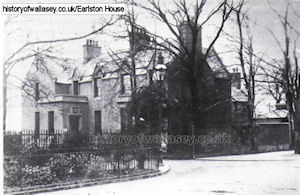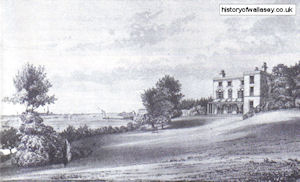By John Saville
It is difficult to visualise Liscard as a medieval manor, with Lords of the Manor and their manor houses and lands. Liscard did, at different times, have two manor houses, each notable in its own way, and each with its own story. With the help of the histories of Wallasey, it is possible to make out a picture of how the manor houses fitted in with the way the area changed over the centuries.
Until Liscard began to grow into a township in the nineteenth century, only a couple of hundred people lived there, mostly working on the manorial fields. Liscard Village consisted of a few cottages while Liscard Moor stretched from the banks of the River Mersey to the boundary with Wallasey Village, Seacombe and Poulton. Until about 150 years ago, the separate villages of Wallasey, Seacombe, Poulton and Wallasey were all distinctive communities, although they all were part of the Parish of St. Hilary.
There had been a number of manor houses, Wallasey Old Hall was the manor house of Wallasey Village from 1604 and was demolished in 1857, Poulton Hall was thought to date from 1665 and was knocked down in 1933, and there were two Liscard Manor Houses, Liscard covered a larger area than it does today, as well as Liscard Village and its fields, it included the area now known as New Brighton, then a desolate waste of sandhills, and Egremont, which was created in the nineteenth century.
When the manor houses of Liscard come into view through the mists of history, we see that they both follow the fashion of the nineteenth century for the wealthy merchant classes of Liverpool to move out of the increasingly crowded and unpleasant growing town centre of the port, to the more salubrious rural atmosphere of Wirral. This was made possible by the steam ferry boats which made it possible for these merchant princes to travel reliably to and from their counting houses in the commercial centre.
 The first manor house in Liscard which is recorded is best known as Earlston House, which is now part of Wallasey Central Library. Early maps show a building called ‘Old Liscard Manor House’. In the early nineteenth century it belonged to John Astley Marsden, a wealthy brush manufacturer of Liverpool who was later to achieve fame as the occupant of ‘Liscard Castle’, or ‘Marsden Folly’ or ‘Brush Castle’ as it was fondly known by the locals. That, however, is another story! Around 1841 the Old Manor House was occupied by George Grant, again lately of Liverpool, who probably changed the name from Liscard Manor House to ‘Rosemount’. This was because in that year, the lordship of the Manor of Liscard had become the property of the Maddock family who, naturally would have liked the prestigious title to belong to their home on the banks of the Mersey. In 1855, Mr Grant left ‘Rosemount’ and it was taken over by Thomas Addison, and later by Robert Bell, who changed the name to ‘Earlston’ around 1860. Various owners came and went but in 1898 ‘Earlston’ was brought by Walalsey Council and a library was opened in the sandstone mansion the following year. The Carnegie Trust gave a grant of £9000 in 1908 and the present red brick library extension was built in 1911. The grounds of ‘Earlston’ stretched as far as Seaview Road and were bought by Wallasey Corporation for an extension to Rake Lane Cemetery.
The first manor house in Liscard which is recorded is best known as Earlston House, which is now part of Wallasey Central Library. Early maps show a building called ‘Old Liscard Manor House’. In the early nineteenth century it belonged to John Astley Marsden, a wealthy brush manufacturer of Liverpool who was later to achieve fame as the occupant of ‘Liscard Castle’, or ‘Marsden Folly’ or ‘Brush Castle’ as it was fondly known by the locals. That, however, is another story! Around 1841 the Old Manor House was occupied by George Grant, again lately of Liverpool, who probably changed the name from Liscard Manor House to ‘Rosemount’. This was because in that year, the lordship of the Manor of Liscard had become the property of the Maddock family who, naturally would have liked the prestigious title to belong to their home on the banks of the Mersey. In 1855, Mr Grant left ‘Rosemount’ and it was taken over by Thomas Addison, and later by Robert Bell, who changed the name to ‘Earlston’ around 1860. Various owners came and went but in 1898 ‘Earlston’ was brought by Walalsey Council and a library was opened in the sandstone mansion the following year. The Carnegie Trust gave a grant of £9000 in 1908 and the present red brick library extension was built in 1911. The grounds of ‘Earlston’ stretched as far as Seaview Road and were bought by Wallasey Corporation for an extension to Rake Lane Cemetery.
We now come to the other Liscard Manor House, known as first as ‘Seabank’, which was found at the foot of Manor Lane, >>>
 overlooking the River Mersey, and set in extensive grounds, the promenade of course not having been built at the time. At the end of the eighteenth century, the Lords of the Manor were the Meoles family and ‘Seabank’ was built around 1790. When the Meoles family died out, the lordship of the manor passed through other hands until in 1797 it was bought by John Penkett. Who had lived and carried on business in Duke Street, Liverpool. He wanted ‘Seabank’ as a summer residence for his family. This of course was at the height of Liverpool’s prosperity with fortunes being made in the infamous slave trade and the growing commerce with the Americas and the East, the lion’s share of which was secured by Mersey shipping. John Penkett died in 1838 and left he mansion to his daughter, Mary Ann, who had married her cousin, John Maddock in 1820. She was known as the Lady of the Manor until she died in 1888 and during that time, the formidable lady exerted considerable influence in the now rapidly growing township.
overlooking the River Mersey, and set in extensive grounds, the promenade of course not having been built at the time. At the end of the eighteenth century, the Lords of the Manor were the Meoles family and ‘Seabank’ was built around 1790. When the Meoles family died out, the lordship of the manor passed through other hands until in 1797 it was bought by John Penkett. Who had lived and carried on business in Duke Street, Liverpool. He wanted ‘Seabank’ as a summer residence for his family. This of course was at the height of Liverpool’s prosperity with fortunes being made in the infamous slave trade and the growing commerce with the Americas and the East, the lion’s share of which was secured by Mersey shipping. John Penkett died in 1838 and left he mansion to his daughter, Mary Ann, who had married her cousin, John Maddock in 1820. She was known as the Lady of the Manor until she died in 1888 and during that time, the formidable lady exerted considerable influence in the now rapidly growing township.
In 1841, to demonstrate the high social status of the Midlands and Penkett families, the name of the riverside mansion was changed from ‘Seabank’ to ‘Liscard Manor House’ and so it continued to be called as the house passed through various owners until in 1882, part of the grounds were sold to provide the site of the Mariners’ Home and in 1925 the Manor House was converted into an infirmary for the aged ex-seamen. It was finally demolished in 1937 but its associations are remembered in local road names, Manor Lane and Manor Road, Seabank Road, Penkett Road and Maddock Road.
Few people now remember the manor house on the river bank, it was a three story house, built of common brick, with a veranda, with lawns sweeping down to the river and pleasantly set among trees and bushes. In 1835 it had been suggested that a ferry to Liverpool could sail from the foot of Manor Lane and that a ferry hotel could be erected in the grounds of the Manor House. Nothing, however, came of these proposals, although no doubt the merchant lords would have found the ferry convenient for their daily voyage to Liverpool, perhaps the thought of commuters frequenting the hostelry was too much and for them to contemplate.
The two manor houses occupied very different sites. ‘Earlston’ is about as far as you can get from salt water in Wallasey and takes up one the highest points in the town. As the name ‘Liscard’ comes from the Welsh “Llys Carrog”, meaning ‘Hall on the Hill’, perhaps it is possible to peer through the mists of time to an age when our Celtic forebears on “Welshman’s Island” sought a safe place to build their first homes.
The rise of the merchant princes of Merseyside is perhaps symbolised by the acquisition of both manor houses of ‘Earlston’ and of ‘Seabank’. From the heights of ‘Earlston’, it would have been possible to enjoy uninterrupted vistas over the Irish Sea while ‘Seabank’ stood in isolated splendour, on the riverside edge of Liscard Moor sand whose only neighbours were the inhabitants of a few cottages, one of these being the infamous ‘Mother Redcap’s’ Inn.
Perhaps we can visualise these commercial memorial lords and their ladies and families, elegantly dressed in the costume of the time, taking their ease and quietly congratulating themselves on their choice of residence, each with its fine outlook, while at the same time, keeping an eye on their ships and cargoes passing within sight of their front windows!
Featured sites
- Non Gamstop Casinos
- Casino Not On Gamstop
- UK Casinos Not On Gamstop
- Non Gamstop Casinos UK
- Sites Not On Gamstop
- Sites Not On Gamstop
- Casinos Not On Gamstop
- Casinos Not On Gamstop
- Casinos Not On Gamstop
- Non Gamstop Casino UK
- Casinos Not On Gamstop
- Non Gamstop Casino
- UK Online Casinos Not On Gamstop
- UK Online Casinos Not On Gamstop
- Non Gamstop Casinos
- Casino Sites Not On Gamstop
- Casinos Not On Gamstop
- Casinos Not On Gamstop
- Best Betting Sites
- Casinos Not On Gamstop
- Gambling Sites Not On Gamstop
- Betting Sites That Are Not On Gamstop
- Non Gamstop Casinos UK
- UK Online Casinos Not On Gamstop